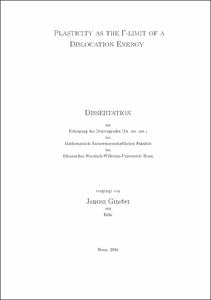Ginster, Janusz: Plasticity as the Γ-limit of a Dislocation Energy. - Bonn, 2017. - Dissertation, Rheinische Friedrich-Wilhelms-Universität Bonn.
Online-Ausgabe in bonndoc: https://nbn-resolving.org/urn:nbn:de:hbz:5n-46126
Online-Ausgabe in bonndoc: https://nbn-resolving.org/urn:nbn:de:hbz:5n-46126
@phdthesis{handle:20.500.11811/7110,
urn: https://nbn-resolving.org/urn:nbn:de:hbz:5n-46126,
author = {{Janusz Ginster}},
title = {Plasticity as the Γ-limit of a Dislocation Energy},
school = {Rheinische Friedrich-Wilhelms-Universität Bonn},
year = 2017,
month = jul,
note = {In this thesis, we derive macroscopic crystal plasticity models from mesoscopic dislocation models by means of Γ-convergence as the interatomic distance tends to zero. Crystal plasticity is the effect of a crystal undergoing an irreversible change of shape in response to applied forces. At the atomic scale, dislocations --- which are local defects of the crystalline structure --- are considered to play a main role in this effect. We concentrate on reduced two-dimensional models for straight parallel edge dislocations.
Firstly, we consider a model with a nonlinear, rotationally invariant elastic energy density with mixed growth. Under the assumption of well-separateness of dislocations, we identify all scaling regimes of the stored elastic energy with respect to the number of dislocations and prove Γ-convergence in all regimes. As the main mathematical tool to control the non-convexity induced by the rotational invariance of the energy, we prove a generalized rigidity estimate for fields with non-vanishing curl. For a given function with values in the set of 2x2 matrices, the estimate provides a quantitative bound for the distance to a specific rotation in terms of the distance to the set of rotations and the curl of the function. The most important ingredient for the proof is a fine estimate which shows that in two dimensions an integrable vector-valued function f can be decomposed into two parts belonging to certain negative Sobolev spaces with critical exponent such that corresponding estimates depend only on div f and the integral of |f|. This is a generalization of an estimate due to Bourgain and Br'ezis.
Secondly, we consider a dislocation model in the setting of linearized elasticity. The main difference to the first case above and existing literature is that we do not assume well-separateness of dislocations. In order to prove meaningful lower bounds, we adapt ball construction techniques which have been used successfully in the context of the Ginzburg-Landau functional. The building block for this technique are good lower bounds on annuli. In contrast to the vortices in the Ginzburg-Landau model, in the setting of linear elasticity, a massive loss of rigidity can be observed on thin annuli which leads to inadequate lower bounds. Hence, our analysis focuses on finding thick annuli which carry almost all relevant energy.},
url = {https://hdl.handle.net/20.500.11811/7110}
}
urn: https://nbn-resolving.org/urn:nbn:de:hbz:5n-46126,
author = {{Janusz Ginster}},
title = {Plasticity as the Γ-limit of a Dislocation Energy},
school = {Rheinische Friedrich-Wilhelms-Universität Bonn},
year = 2017,
month = jul,
note = {In this thesis, we derive macroscopic crystal plasticity models from mesoscopic dislocation models by means of Γ-convergence as the interatomic distance tends to zero. Crystal plasticity is the effect of a crystal undergoing an irreversible change of shape in response to applied forces. At the atomic scale, dislocations --- which are local defects of the crystalline structure --- are considered to play a main role in this effect. We concentrate on reduced two-dimensional models for straight parallel edge dislocations.
Firstly, we consider a model with a nonlinear, rotationally invariant elastic energy density with mixed growth. Under the assumption of well-separateness of dislocations, we identify all scaling regimes of the stored elastic energy with respect to the number of dislocations and prove Γ-convergence in all regimes. As the main mathematical tool to control the non-convexity induced by the rotational invariance of the energy, we prove a generalized rigidity estimate for fields with non-vanishing curl. For a given function with values in the set of 2x2 matrices, the estimate provides a quantitative bound for the distance to a specific rotation in terms of the distance to the set of rotations and the curl of the function. The most important ingredient for the proof is a fine estimate which shows that in two dimensions an integrable vector-valued function f can be decomposed into two parts belonging to certain negative Sobolev spaces with critical exponent such that corresponding estimates depend only on div f and the integral of |f|. This is a generalization of an estimate due to Bourgain and Br'ezis.
Secondly, we consider a dislocation model in the setting of linearized elasticity. The main difference to the first case above and existing literature is that we do not assume well-separateness of dislocations. In order to prove meaningful lower bounds, we adapt ball construction techniques which have been used successfully in the context of the Ginzburg-Landau functional. The building block for this technique are good lower bounds on annuli. In contrast to the vortices in the Ginzburg-Landau model, in the setting of linear elasticity, a massive loss of rigidity can be observed on thin annuli which leads to inadequate lower bounds. Hence, our analysis focuses on finding thick annuli which carry almost all relevant energy.},
url = {https://hdl.handle.net/20.500.11811/7110}
}






